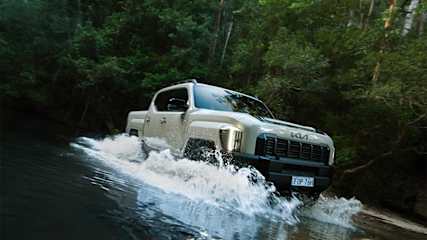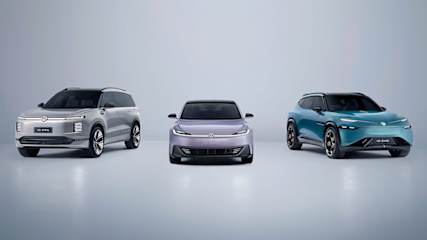2025 Kia Tasman price and specs comparison: How does the bold new ute shape up against the popular Ford Ranger, Toyota HiLux and Isuzu D-Max?
By Samuel Irvine · 25 Apr 2025
Kia Australia has some big expectations for its incoming Tasman ute. Most notable is the brand's aim of off-loading 20,000 units in its first full year, the equivalent to one quarter of the Tasman’s projected global sales.To do so in a shrinking ute market, it will need to lure Australian buyers away from traditional staples in Ford, Toyota and Isuzu while fighting off an increasing cohort of budget Chinese rivals, such as BYD, GWM and JAC.Achieving that will be no easy feat and require the Tasman to be competitive on the basics: grunt, payload, towing, tech, and arguably most important of all, price.So, does it? We’ve put the Tasman's top-grade head-to-head against some of Australia’s most popular ute models in an on-paper comparison designed to give you the best run-down on the all-new model before we've even taken it for a test drive.Starting with ground clearance, at 252mm, the Tasman exceeds its rivals by a minimum of 12mm. You could argue it's a relatively paltry difference, but 4WD enthusiasts would argue every millimetre counts when you're traversing rough terrain.Approach and departure angles is another area where the Tasman shines. At 32.2-degree approach and 26.2-degree departure, the Tasman shapes up as a symphony of well thought out proportions, something that will, once again, make it appealing to the four-wheel driving class.As an additional note, Kia claims to have "best-in-class" tub volume at 1173 litres, which sounds unusual given it doesn't have the largest tub dimensions in this class. Rather, its tub width and length are smaller than the Ford Ranger Wildtrak and Toyota HiLux Rogue. Further enquiries with Kia found that its best-in-class claim is according to VDA specifications, a commonly used European cargo space measuring guide. Ford, meanwhile, claims a tub volume of 1233-litres on the Wildtrak (a whole 60 litres more), though it's unclear what measurement guide the figure is based on.If its raw torque and power you're after, prospective buyers may be a little disappointed with the Tasman's outputs – at least on paper.But don't let the figures trick you into thinking its not a capable ute. In fact, it leads all of its rivals on payload, while delivering benchmark 3500kg towing; something the new plug-in hybrid BYD Shark 6 (321kW/650Nm) couldn't conquer.Kia said the decision to offer a 2.2-litre turbo-diesel four-cylinder engine, which falls 30kW/59Nm short of its most powerful rival (the V6 Ford Ranger Wildtrak), was based on the brand's decision to comply with Australia's New Vehicle Efficiency Standards (NVES). The scheme penalises carmakers who exceed government-mandated carbon emissions limits.While Kia is yet to officially release homologated emissions data on the Tasman, its relatively strong fuel consumption of 7.6 litres/100km suggests it will duck under the targets many of its rivals will fall victim to.This is one area where the Tasman decisively leads the segment, particularly in terms of tech and comfort. It carries twin 12.3-inch screens for multimedia and the digital driver's display, with a 5.0-inch touch monitor for climate controls wedged in-between.There's wireless Apple CarPlay and Android Auto connectivity, digital radio, wireless charging, quilted leather upholstery and intuitive features like a large folding-table mounted to the centre console.Kia claims the Tasman has "class-leading" headroom, shoulder room and second row legroom, which makes sense given it is the longest vehicle in its class. The Tasman also comes with an additional 33 litres of under seat storage.The Ranger Wildtrak's interior set-up comes the closest, with a 10.1-inch portrait-oriented touchscreen and an 8.0-inch digital driver's display. It carries wireless Apple CarPlay and Android Auto connectivity, too, as well as wireless charging and digital radio. Under seat storage is offered on the Wildtrak, however, Ford chooses not to quote a litre figure.The D-Max X-Terrain carries a smaller 9.0-inch multimedia touchscreen with wireless Apple CarPlay and Android Auto, along with an 8.0-inch digital driver's display. It misses out on wireless charging, though.The HiLux Rogue is well off the pace, providing only an 8.0-inch colour touchscreen with wired Apple CarPlay and Android Auto, no wireless charging pad and fewer clever storage spaces. Toyota is, however, set to upgrade this configuration next year when the new HiLux arrives.* All prices calculated before on-road costsPricing was one area where the Tasman was expected to spank the established competition, though its entry price of $42,990 before on-roads for the two-wheel drive S grade exceeds all its rivals by at least $6110.That likely comes down to higher production costs (the Tasman is built in South Korea, while its rivals are built in Thailand) and a more generous offering of standard features.By no means, however, is the Tasman exuberantly expensive, as evidenced by the X-Pro's mere $150 premium over the Wildtrak – a popular variant of Australia's most popular ute. But the success of budget Chinese brands, such as BYD, Chery, GWM and MG, in Australia has shown buyers are increasingly willing to prioritise value above all else, which could hurt the Tasman's sales prospects.Despite the conjecture online about the Kia Tasman's design, which does take a little getting used to, the Tasman is, by all means, a compelling package.It delivers and, in fact, exceeds the competition on several fundamentals, from ground clearance and approach/departure angles to payload, fuel efficiency, interior comfort and tech.That said, two key factors may not necessarily work in its favour - design and price. In a world where buyers are becoming increasingly cost-conscious, there may be a tendency to opt for more conventionally-styled budget rivals.As always, though, only time will tell whether the Tasman can live up to its maker's expectations.
.jpg)








